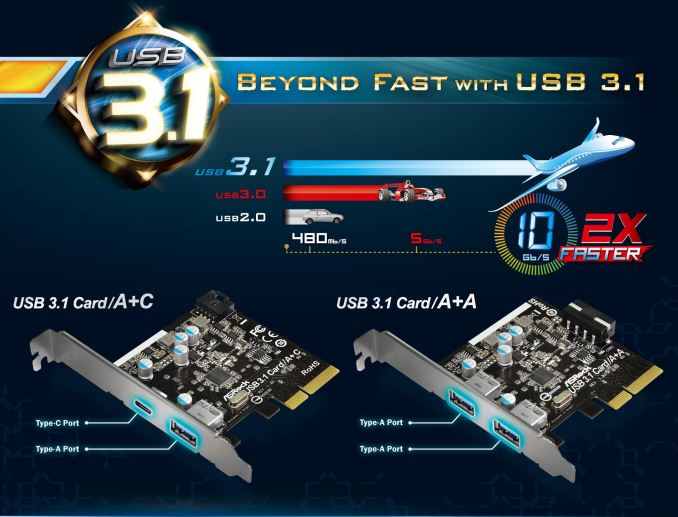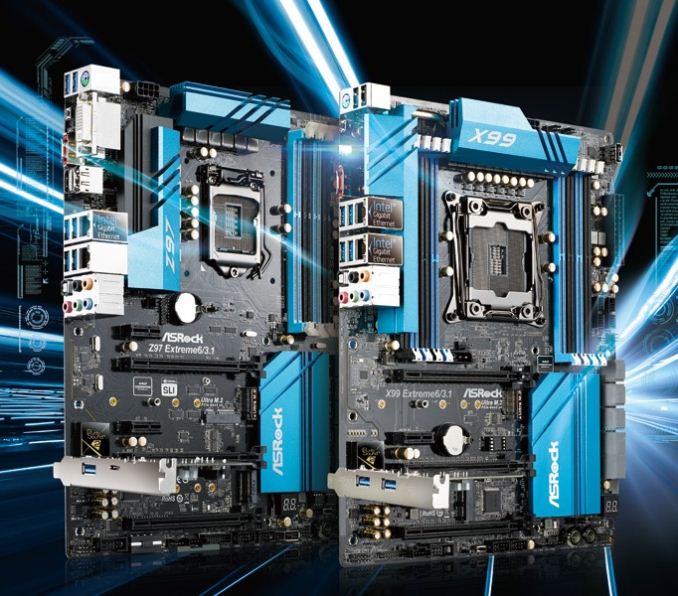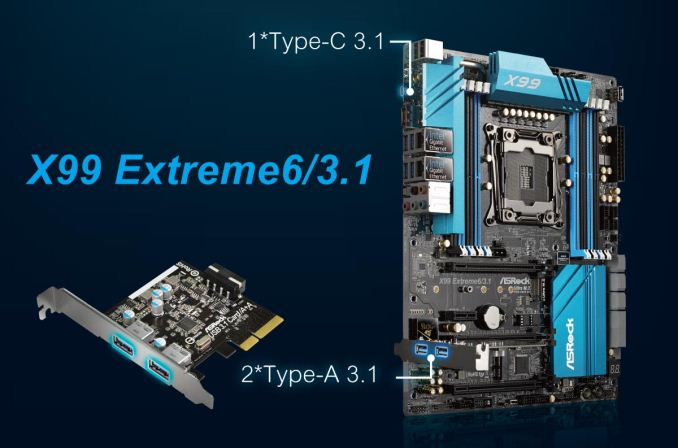ASRock to Introduce USB 3.1 Cards and Motherboards
by Ian Cutress on February 16, 2015 7:35 AM EST
On the back of our USB 3.1 performance coverage, as well as seeing some motherboards in the flesh at CES, other manufacturers are now announcing their USB 3.1 implementations. ASRock distributed a press release today confirming that they will be launching a couple of interesting USB 3.1 devices. Up first are the USB 3.1 PCIe cards, capable of either two Type-A ports or a combination of Type-A and Type-C.
These cards look to be PCIe 2.0 x2 cards, giving the 10 Gbps needed to saturate a USB 3.1 port. It is worth noting then that the combined throughput of two ports on one card will be 10 Gbps, rather than 10 Gbps on each. Interestingly each card seems to have a power requirement – on the dual Type-A card there is a 4-pin molex whereas on the combo card there is a 4-pin custom/floppy sized connector. The power connectors on each card allow each port to provide up to 3 amps at 5V, giving 15W charging a possibility. (Unfortunately dreams of 100W charging are still in the air at the moment, as it requires a power delivery design to step up 12V to 20V at 5A, as well as providing a 100W source though a power connector.)
ASRock will be providing these cards as bundles in two models – the Z97 Extreme6/3.1 and the X99 Extreme6/3.1. The Z97 model will come with the combination A+C card whereas the X99 will come with two Type-A because the board will already come with a Type-C onboard.
This means that the X99 Extreme6/3.1, with the PCIe card installed, should be capable of three USB 3.1 devices being attached. All we have to wait for now is USB 3.1 devices to actually come to market. In that respect it might be worth considering that buying these now will require waiting for the rest of the industry to catch up.
ASRock did not distribute any pricing or launch window information as this was a global press release, but I would imagine within the next month to see something on the shelves. I have had a Skype message offering a board for review, so they must be near-final.















53 Comments
View All Comments
Beaver M. - Monday, February 16, 2015 - link
Who the hell needs faster USB 3? Im still trying to find a USB stick that uses the whole bandwidth.I only want the new connectors.
Impulses - Monday, February 16, 2015 - link
For external/portable SSD? Dunno my sticks hover at 200MB/s tops and my external backup drive is still mechanical. I'm all for progress and anything that starts moving us towards Type C everywhere tho.haukionkannel - Monday, February 16, 2015 - link
Exactly! I have San-disk extreme 480 Gb as an external storage and usb 3.1 would give good boost to it! The 3.0 is not too bad, but the SSD could be even faster with 3.1.Beaver M. - Monday, February 16, 2015 - link
You really think those ~100 MB/s more will make a huge difference when you already have around 400 MB/s? Doesnt pretty much every mainboard nowadays have eSATA anyway? Even my 5 year old one has one, so does my 2 year and 3 year old one and also my 1 year old one. I want god damn sticks that run 400 MB/s, hell, even real 350 MB/s would be awesome.Gigaplex - Monday, February 16, 2015 - link
eSATA is less common than it used to be.Denithor - Monday, February 23, 2015 - link
eSATA is less common, likely due to USB 3.0 coming out. Plus, biggest drawback to eSATA is - no power provided for your peripheral. Not just no charging, no power period, must use external power supply to even use a drive connected to eSATA.jpak725 - Monday, February 16, 2015 - link
I'm all for the new type C connectors...but having the cards powered through a molex/floppy connector is kind of funny to me. when will a new power standard be created? the 24pin mb cable is the worst of them allbill.rookard - Monday, February 16, 2015 - link
I agree, but it's a chicken/egg problem with that. The standard (20+4) is so entrenched that putting out a new spec would require motherboard manufacturers to make motherboards with the 'new' connector, along with the PSU manufacturers. BUT, then you have two different standards coexisting side by side due to the relatively long (3+ years) upgrade cycle between MOBOs and/or PSUs.This creates confusion, forces upgrades to people who don't want them etc. It could all be relatively solved by modular setups (ie: a type 1 (20+4) or a type 2 (whatever new standard) MOBO cable for power delivery).
I'm curious though what you would suggest. I can envision a relatively heavy duty 6 wire setup (12v+/-, 3.3v+/-, 5v+/-) made of something in the 10-12 gauge range which would provide sufficient power for most setups (10 gauge is rated for roughly 50ish amps * 12v = ~600 watts, 3v = 165w) while still being flexible enough to route (~3mm core).
It would certainly be better for most peoples usage cases and much simpler as they only have sub-200watts.
DanNeely - Monday, February 16, 2015 - link
Modular cabling is only found in some high end PSUs. I don't think it's a reasonable option to retire the 24 pin connector.My idea is to stage past the chicken/egg problem similar to how the -5v (used for ISA cards) pin was made optional in v1.2 and deleted from the 1.3 spec.
In it's simplest form, the first round of this would be to make the -12v, 3/4 3.3v, 4/5 +5v and 5/8 ground wires in the 12pin cable optional. That would reduce the cable from 23 to 10 wires making it much easier to route. Then a few years later, just define a new 10pin main connector to replace the mostly empty 24pin one to reclaim mobo space. At this point back compatibility with systems from a few years ago could be maintained with a simple 10-24pin adapter.
Depending on how ambitious you think the ATX people are, you could tweak it several ways:
1) Drop 3.3v completely. With legacy PCI going away, I think the only thing in a modern system using 3.3v is the TPM. For as little power as that needs, it could be generated on board easily enough.
2) Add a +20V wire for the high power USB charging spec. I have somewhat mixed feeling here though. Aside from thinking the USB forum's one cable to plug them all dreams are a bad idea, most OEM desktop systems aren't going to have a PSU with enough extra capacity to provide 100W to charge a laptop while still being stable under heavy use. Unless we start seeing fast charge phone/tablets taking 0.5-1A of 20V power instead of 5/12V I lean against adding 20V to the standard connector.
3) More 12V. Within reason this could be a good thing; but trying to replace the 8 pin 12V connector by just moving the pins back to the big one would result in another obnoxiously huge cable again. If a single 12V/ground pair would be enough to let low power miniITX systems stop needing a 4pin 12V connector it seems like a reasonable tradeoff and a 12 wire cable still wouldn't be too unwieldy.
4) +12/20V standby wire? This'd let you charge a high voltage USB device while the computer is on standby and otherwise shut down. On one hand, if done like +5VSB, it'd add another stand alone (low efficiency) PSU into the system. On the other hand, 80+ titanium requires 90% efficiency at 10% load; so mainstream size PSUs efficient enough to run standby modes on the main generation circuit might be within reach.
5) Keeping the pinout the same but requiring thicker wires to deliver more current. My main worry here is about over current failure modes. If part of the system is rated to deliver 10A but another part was designed around never seeing more than 5A magic smoke (or even an actual fire) seem to be worryingly possible.
phoenix_rizzen - Monday, February 16, 2015 - link
Modular cabling is available in sub-$100 PSUs from all kinds of generic brands. It's actually getting to be difficult to find non-modular PSUs on Amazon these days (which is a very nice thing to see).